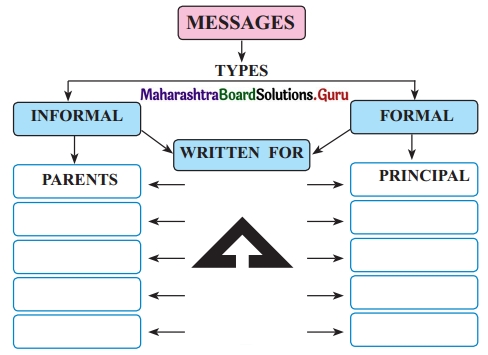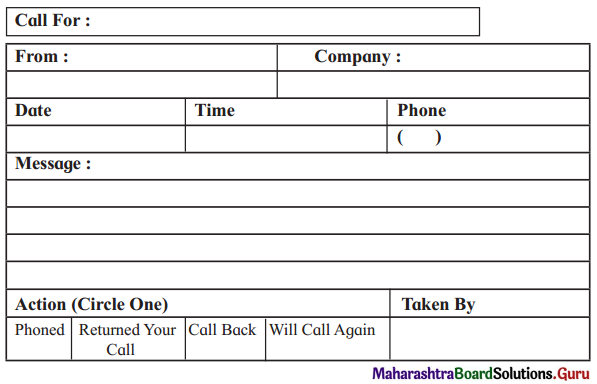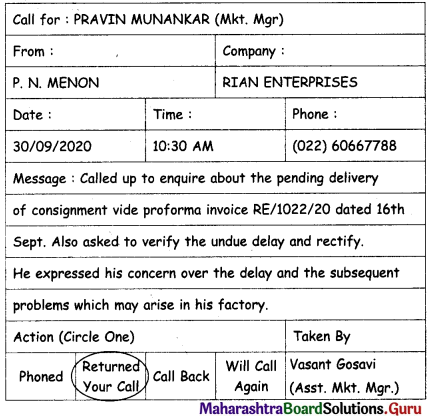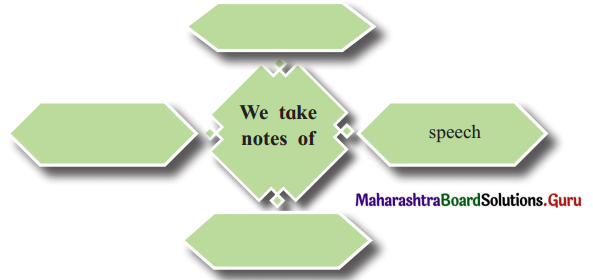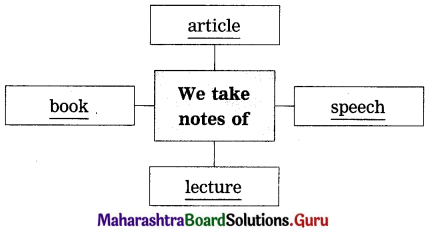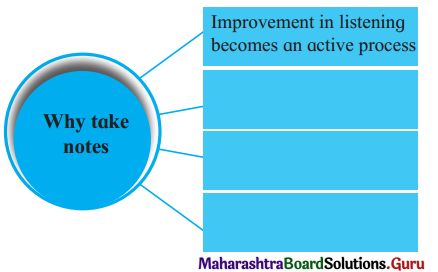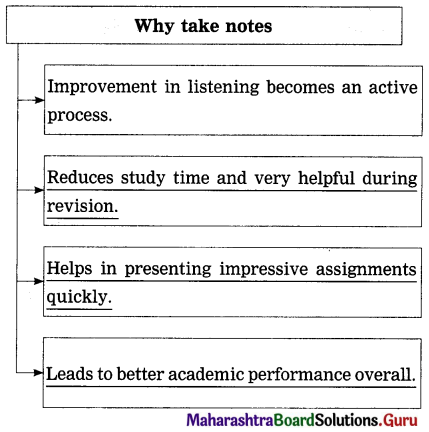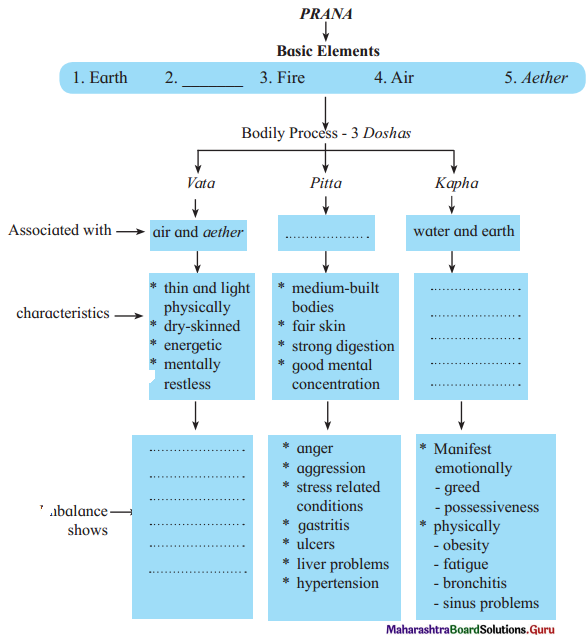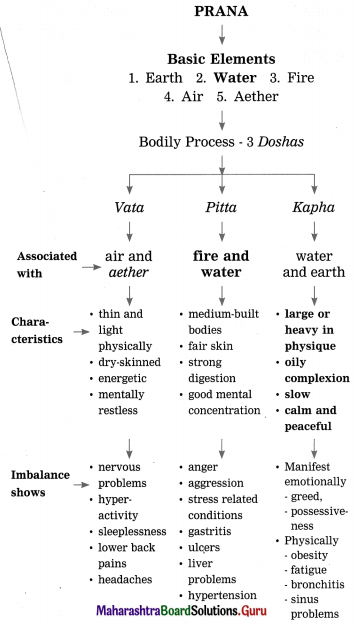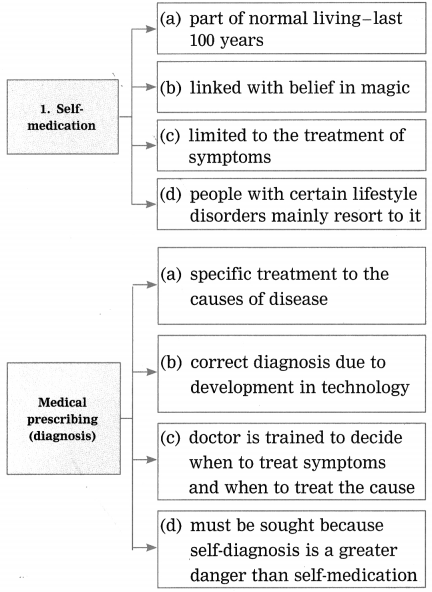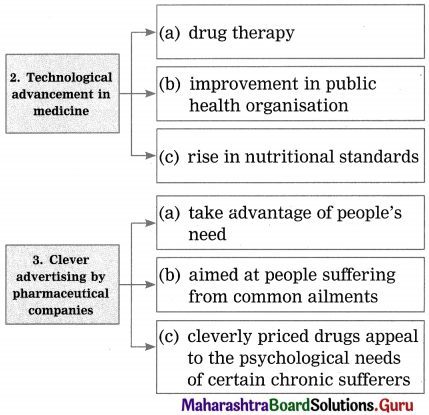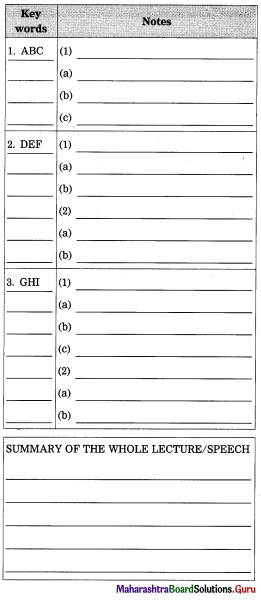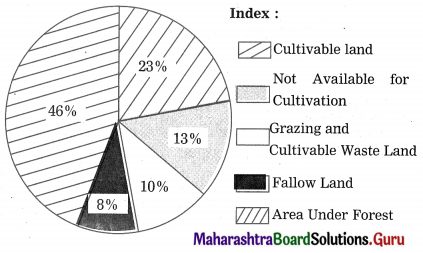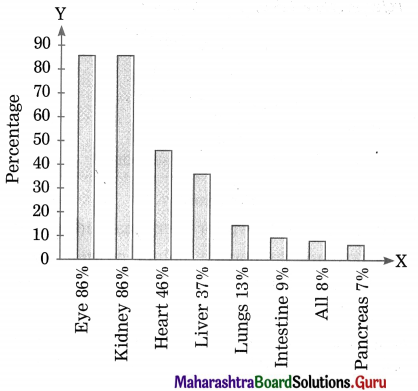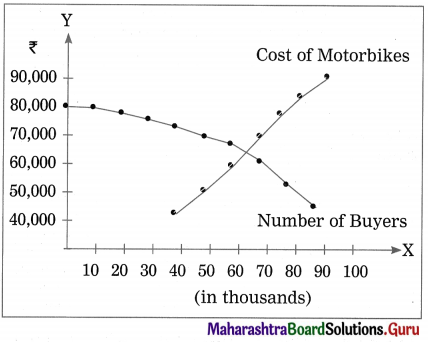Balbharti Yuvakbharati English 12th Digest Chapter 3.4 Statement of Purpose Notes, Textbook Exercise Important Questions and Answers.
Maharashtra State Board Class 12 English Yuvakbharati Solutions Chapter 3.4 Statement of Purpose
12th English Digest Chapter 3.4 Statement of Purpose Textbook Questions and Answers
Question 1.
Match the professions with the desired qualities: (The answers are given directly.)
Answer:
- Businessman – c. convincing, selling, risk-taking
- Artist – d. imaginative, creative, thinking out of
- Advocate – e. logical reasoning, oratory, critical thinking.
- Police – b. alert, investigative, love for physical activity
- Scientist – a. reading, experimenting, researching

Question 2.
What is your career goal?
Answer:
My career goal is to be an astronaut.
Question 3.
Which of your qualities would help you in achieving your career goal?
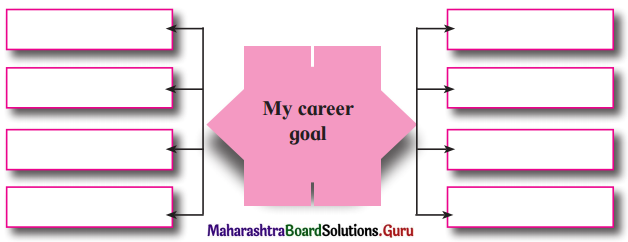
Answer:
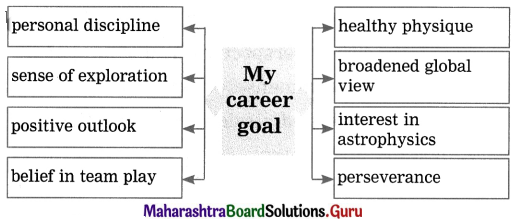
Question 4.
List the obstacles which might hamper in achieving your goals in life. One is done for you.
Answer:
- Lack of proper guidance.
- Opposition from family for choosing a strange career.
- Lack of knowledge about the career prospects.
- Lack of training centres in our country at present.

(A1)
Question 1.
Discuss and exchange your views with your partner about your career plan
Answer:
- My Partner: I think I should now think of a definite career plan. Have you ever thought of a career plan?
- Myself: Of course! I have a definite plan and I am quite focused on it.
- My Partner: Would you mind sharing your goals with me?
- Myself: Why not? You are my friend and you have every right to know it.
- Myself: I want to be a doctor. It is not that primary school ambition when every one wants to be an engineer or a doctor.
- My Partner: I wanted to be an airline pilot during those days.
- Myself: There could be many like you. Those were just fleeting fancies. You just can’t call them career goals.
- My Partner: Do you think your plan is real and practical?
- Myself: Surely I do! That’s why I call it my career plan. My whole focus is on it. I work hard to achieve my goal.
- My Partner: There are many doctors around and I don’t find any particular charm to be one among those ‘white coats’.
- Myself: Oh, yes! You are free to have your opinions, but whatever I do will have my personal stamp on it. I am unique and I am going to be a unique doctor.
- My Partner: Is that something like going to the villages barefoot?
- Myself: Could be that. Perhaps much more than that. You will see it yourself sometime in the future. I am quite steadfast in my resolve.
- My Partner: Okay, okay. I wish you all the best. I wish I had your will to win.

(A2)
Question 1.
You must have decided your aim in life. Which institute/university would you like to join for your diploma/ graduation. Write a Statement of Purpose as a part of your application to the institute/university.
Answer:
I would like to graduate in history from Birkbeck College under the University of London. Given below is my Statement of Purpose attached as part of my application.
Statement of Purpose:
For me, history was just a list of monarchs, a catalogue of wars and a chronicle of dynasties. All this changed when I reached the VUIth standard. I was, then, fortunate to study history under a dynamic teacher. He changed my perspectives. I realized that there is social history and economic history. There is history of science and ideas. The tipping point came when my teacher introduced me to the Bhakti Movement.
I realized that I belong to the land of Saints – Maharashtra. The lives of saints fascinated me. I delved deep into books to know more about their work and time. I read about Sant Namdeo, Sant Dynaneshwar, Sant Eknath, Sant Tukaram and Ramdas Swami. What I gained, of course, was very precious. My fascination with the subject grew by each passing day.
My aim in seeking admission to your college is that you have a very good department in South Asian History. I know that the late eminent historian Eric Hobsbawm taught in your college throughout his career. Likewise, the famous R. J. Evans and Roy Foster were once members among your faculty. So I am hopeful that I would get a chance to learn under world class teachers once I get into your esteemed institution.
My broad plan is to have a sound grounding in the medieval socio-economic history of India during my graduation years and then move on to the Bhakti Movement during my post-graduate studies. Doctoral and post-doctoral research would be focused on the life and work of a single saint.
I am an avid reader. I hope my exposure to saint literature in Marathi would stand me in good stead. I am a state-level chess player. Chess, as per the game theory, is a full information game. Your opponent see on the board as much as you see. However, the patient search for possibilities pay the dividend. The player processes the various permutations and combinations and finally makes that unique move – the winning move! I am sure that I have it in me.
I worked as an amateur research assistant to Dr. Pendse while he was working on his monumental work on the Bhakti Movement. I also have a diploma in “Indexing Books in Humanities”. I earnestly hope that an exposure to the excellent academic atmosphere prevailing in your prestigious institution would bring forth the best in me and thus allow me to contribute my mite to the rich cultural heritage of my land!

(A3)
Question 1.
Enrich your vocabulary.
Match the job terms with their meanings.
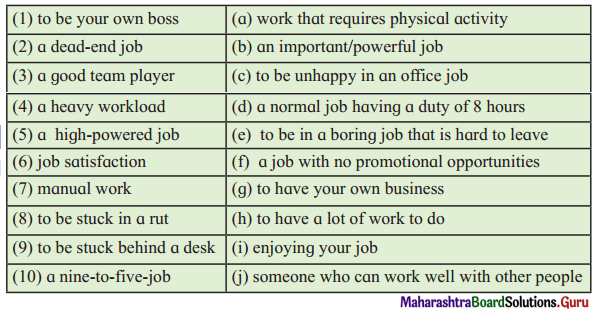
Answer:
- to be your own boss – (g) to have your own business
- a dead-end job – (f) a job with no promotional opportunities
- a good team player – (j) someone who can work well with other people
- a heavy workload – (h) to have a lot of work to do
- a high-powered job – (b) an important/ powerful job
- job satisfaction – (i) enjoying your job
- manual work – (a) work that requires physical activity
- to be stuck in a rut – (e) to be in a boring job that is hard to leave
- to be stuck behind a desk – (c) to be unhappy in an office job
- a nine-to-five job – (d) a normal job having a duty of 8 hours
(A4)
Question 1.
Read the dialogue given below and fill in the blanks with the appropriate job terms given above.
(The answer parts are underlined.)
Answer:
Varsha: Vivek, what kind of a job are you looking for?
Vivek: Varsha, I want to be my own boss. I don’t like a nine-to-five job. My present job is not challenging. I am stuck behind a desk. I am not afraid of a heavy workload and I am a good team player. Moreover, this is a dead-end job. I am looking for an opportunity to try new winds.

A5. Read the personal details given below and prepare a suitable Statement of Purpose:
Question (i)
University of Bath, UK is one of the leading Universities for Business Studies. You belong to a business family – wish to start your own business, carry forward your family business in future. In your junior college you have opted for commerce, scored well in your Std. X Board examination – You made profit in the stall you had put up in the business fair organized by your school/ college. Your hobbies are playing cricket/ hockey – you get along well with people.
Answer:
I belong to a family which had a long tradition in business. My father is a third generation businessman. I grew up meeting relatives who are in some business or the other. Naturally, I have never thought of any pursuit other than business.
My family business is doing quite well but the world of business is changing rapidly. To keep up with the changing times, I must keep abreast of the new developments in the world of business. Hence I aspire for a degree in business studies from an institution of high standing as yours.
I did exceedingly well in my Standard X Board Examination scoring impressive marks in Maths and English. For the junior college I opted commerce as my main stream. Accountancy is my favourite area of study. I feel quite comfortable with the subject because balance sheet analysis, stocks, trade, tariff, etc. have always been the words in currency during any of the family gatherings.
A cool head on his shoulders is a must for a businessman. With an agitated mind you can’t ever take the right decisions. I am cool by nature. I assess the pros and cons with a dispassionate mind. No wonder that I was always made the captain of our cricket team. Cricket being a mind game as well, one needs to make quick and effective decisions. Moreover, one needs to make one’s team mates believe that the decision is theirs! There lies the magic of a team player and leader and so far I have been a great hit at it.
As they say, the proof of the pudding is in the eating. Just thinking that I am endowed with great business acumen would remain a mere boast until I prove it with an example. Luckily I had a great chance coming my way during the business fair organized by our college.
What I proposed was a stall selling helmets. The principal flatly rejected the idea saying that in a college where most of the students are under-18 and are not eligible for a driving licence, it was preposterous to come out with such a bizarre idea. I persisted and somehow got the permission. It was a three-day fair.
On the first day, just as I had expected, many students told me that their siblings and parents do have helmets at home – but they don’t wear it. This was the tipping point. I asked them to bring those unworn helmets the next day. I would compensate for the old ones – they need to pay only the difference for the new ones. (I had already made a tie-up with a second-hand helmet dealer. I offered an environment-friendly bag as well to each prospective buyer.)
Students, especially girls, warmed towards the idea greatly. Being a gift, their brothers or parents just won’t be able to neglect the helmets. The magic word here was ‘gift’; and the sentimental aura surrounding the gesture. The venture clicked. I made a handsome profit. The satisfaction of being instrumental in saving many lives was a bonus.
I know for sure that the case narrated above is not a path-breaking event. But for me, it was an eye-opener. I realized that business is mainly a game based on human psychology. Reading a bit of behavioural economics taught me that not all economic demands stem from rational thought.
Yes, your prestigious institution can offer me what I seek. I seek something more than a degree in business studies. Your esteemed faculty, I hope, will provide me the right exposure I need. I look forward to novel ventures. I want to tread on an unbeaten path. For me, business is not just about making money. It is the thrill of living every moment in the exhilaration of weighing choices and making decisions. For that I need to learn new things. For that I need to get into an institution like yours.

Question (ii)
You are an avid animal lover. You have a pet dog and some lovebirds at home. You are extremely fond of them. You have been a member of bird watcher’s club. You have loved going on a safari. You have taken care of orphan animals, or animals who are hurt. In school you loved Biology. You wish to make a career in this field. The University of Cambridge offers an excellent course/ programme which would boost your career. Make a Statement of Purpose which will help you to get admission to this University.
Answer:
Statement of Purpose
I was captivated by the world of animals much early in my life. There are of course, many people around who love animals; but I doubt whether they share the same intensity which I have. I love animals of all softs. I care for animals big and small. I equally love the ones who fly and the ones who crawl.
My parents have been quite supportive of my passion. My collection of lovebirds and the pet dog which I have now are their gifts. I observe my pets and all other animals around me with undiminishing curiosity. Their behaviour fascinates me: Though ‘biology’ has been my favourite subject all along, I never knew that there are courses catering to my specific need. So your biology graduation course with focus on animal behaviour is “the one” I sought after.
I very well know that observation and study of animals demand infinite patience. Many senior members of our “Bird watchers’ club’ usually appreciate my great patience. I also have an eye for detail. Each time I go for a safari, I notice something new. Each time there seems to be a revelation of sort.
If I say I care for my pets that would be just stating the obvious. My love for animals goes beyond boundaries. Any animal suffering or struggling anywhere is my concern. There have been umpteen cases where I took care of and tended orphaned animals; but each case was unique and every one of them is etched in my memory in its vivid detail.
Though my interaction with animals has a long record, my theoretical studies about animals are not much to boast of. I have read the works of Nikolaas Tinbergin, Konrad Lorenz. Karl Von Frich and Ivan Pavlov – all pioneers in the field of animal behaviour. Nevertheless, I know that a lot has been happening of late. Moreover, I wish to learn the discipline in an organized way. And your esteemed institution is “the place” for it. I am hopeful that I will be able to contribute something significant to the field I love most.

(A6)
Question 1.
Browse different websites and find out the universities offering best courses in life Sciences, Arts, Sports, Music, Engineering and medicine. Collect and share any other additional information related to the course which seems important.
(Students may attempt this on their own.)
![]()
![]()
![]()
![]()




![]()


![]()





